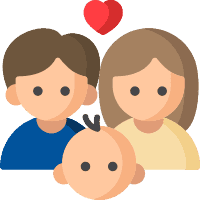As natural as it may feel when you’re an adult, eating is a learned behavior. Infants and children must discover–and be taught–how to consume food and liquids. And it’s not always as easy as you might think. First you must get the food in your mouth; then you have to keep the food there while you chew and prepare to swallow. At the end of all that, you have to successfully swallow the food! Most kids pick up the skill pretty quickly–but not always due to pediatric feeding and swallowing disorders.
When children have trouble learning how to eat a variety of tastes and textures, it may be a sign of pediatric feeding or swallowing difficulties. Delays and disorders can present in a variety of ways and at any number of ages, but most concerns can be successfully addressed with the right support from a pediatric speech-language pathologist.
What Causes Pediatric Feeding and Swallowing Disorders?
Kids can sometimes exhibit difficulty with feeding and swallowing as they learn new skills and behaviors. But challenges with biting, chewing, varied textures, or swallowing that linger as children age can be signs of feeding and swallowing delays, difficulties, or disorders.
The cause of these disorders is not always well understood, and will vary considerably from child to child. For example, some evidence suggests that preterm birth may be a significant risk factor for developing feeding disorders. In other cases, a feeding disorder may result from muscle strength and coordination, structural breathing problems, tolerance to textures or even digestion.
Common Symptoms
The presentations for feeding and swallowing disorders will vary somewhat from individual to individual. For example, symptoms are likely to be somewhat different in young children than they are for teens. Common symptoms and signs span both physical and emotional presentations and may include:
- A child that cries or becomes fussy around meal times or during meals.
- A child falling asleep during meal time.
- A stiff or arched back during feeding.
- Coughing during eating.
- Gagging on foods.
- Excess drool or saliva excretion while eating.
- Changes in the voice or breathing during meals (for example, becoming hoarse or breathy).
- Vomiting during meal times or after eating.
- Trouble putting on a healthy amount of weight or growing (especially in young children).
- Exhibiting trouble breathing while eating.
- A child that prefers certain food textures to others (for example, if your child gravitates towards soft, chewy foods instead of crunchy foods).
- A child that exhibits visible difficulty swallowing.
This list is not exhaustive, and each child could have a different presentation of various symptoms, depending on the specific feeding or swallowing challenges at work.
Diagnosing Pediatric Feeding and Swallowing Disorders
Presentations of swallowing or feeding disorders may be obvious or subtle. Either way, it’s essential that your kiddo be diagnosed by a professional. Most commonly, a pediatric speech-language pathologist will be responsible for offering that diagnosis.
In some cases, medical specialists may also perform a special diagnostic called a modified barium swallow. Barium is a special chemical that’s visible in an x-ray, so the track the swallowed food takes will be visible. In still other instances, a special endoscopic examination will need to be performed to assess your child’s disorder.
During your visit, your Speech-Language Pathologist may discuss something called dysphagia. This is a medical term referring specifically to swallowing disorders.
Therapeutic Treatments for Feeding Disorders and Dysphagia
Treatment for your child’s dysphagia or feeding delay or disorder will depend significantly on the nature of their ailment. For many children, the best way to treat swallowing or feeding delays or disorders is by working closely with a speech-language pathologist who specializes in feeding. Treatment can take several forms, but often include:
- The creation of a food plan: The creation of a detailed food plan that can help you make sure your child or teen gets required nutrients while avoiding food triggers. A food plan is designed to avoid malnutrition and focus on helping your child stay healthy, fed, and growing.
- Food therapy: The right food therapy plan can help your child learn new skills or work on diminishing specific triggers. For example, your child will be introduced to new textures or move from soft to crunchy textures in a way that is comfortable and safe.
There are some things you can do at home, too. For example, you could work to improve your child’s eating posture, which may help with chewing and swallowing. You can also play with temperature and texture–maybe your child usually dislikes crunchy food but enjoys cold crunchy food.
You can work with your child, especially within the guidelines of your food plan and under the advice of your child’s Speech-Language Pathologist to discover new foods that they may enjoy.
Get a Professional Opinion
It’s easy for some parents to see the presentations of feeding and swallowing difficulties, delays or disorders and dismiss them as nothing more than the sign of a picky or fussy eater. But feeding and swallowing disorders could be a sign of a separate or underlying issue. As a result, it’s always best to have these issues professionally diagnosed and treated.
It’s not uncommon for parents to have questions about these pediatric feeding and swallowing disorders. The Speech-Language Pathologists at the Center for Speech & Language Development are among the top experts in pediatric difficulties, delays, and disorders, offering some of the region’s most effective treatments for these issues. To get the answers you need, contact us to make an appointment or take advantage of our free, online office hours to have a preliminary discussion with a nutritional therapist.



